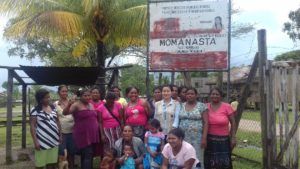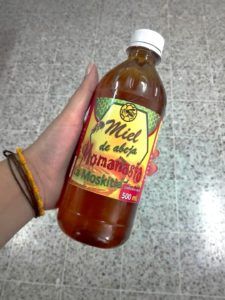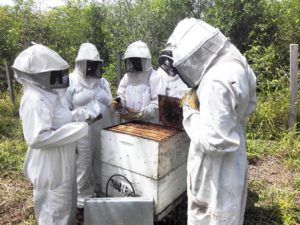 Stories
Stories
August 14, 2020 • 4 min read
GOAL has long supported the development and growth of the indigenous communities in the Honduran Moskitia. However, there are certainly many challenges remaining in reversing the social, cultural and economic exclusion of indigenous peoples and to promote the understanding of their worldviews, community life, spirituality, respect and vindication of their rights.
The evening falls in the community of Mocorón, in the Honduran Moskitia, and several women of the Mixed Cooperative of Miskito Women (MOMANASTA) return from caring for their bees. Until recently, the livelihoods of their families depended exclusively on artisanal fishing and self-consumption agriculture. However, with honey production they hope to form a community business that contributes to the livelihood of their families and improves their quality of life. And yet, it has to be said that the life of indigenous peoples in Honduras has never been easy.
In this Central American country, one of the poorest in Latin America, there are nine culturally differentiated villages: Chortís, Lencas, Miskitos, Nahuas, Pech, Tawahkas, Tolupanes and the Afro-descendant Garífunas and Black English-speaking peoples. Although the State of Honduras officially recognizes the multicultural and multilingual character of Honduran society, indigenous communities have always been marginalized. They often live in rural areas characterized by extreme poverty, lack of access to basic services, high degrees of malnutrition, high rates of illiteracy, disrespect to their culture, violence and insecurity in land tenure and other forms of exclusion.
Since GOAL began working in Honduras, it has recognized the enormous challenges indigenous peoples face in the full fulfilment of their rights. Thus, with the support of strategic partners and communities, it has promoted and accompanied processes aimed at reducing poverty; promoting food security; improving access to basic services; prevention and risk management and promoting resilience.

Members of the female MOMANASTA beekeeper group celebrate their graduation from the administration skills training.
An example of this was the project “Improving the Coverage of the Productive Forest under Agroforestry Systems in Miskito, Pech, Tawahka and Tolupan communities”. This project contributed to increasing the adaptability and mitigation of Honduran Indigenous and Afro-American Peoples to climate change and to reducing their vulnerability to climate risks affecting their well-being and culture.
Another project implemented by GOAL is “Adaptation to Climate Change with Community Forestry Approach in the Indigenous Communities of the Honduran Moskita (ACCFOR MOSKITIA)”. This project seeks the innovation of community forestry aimed at improving living conditions, food security and the domestic economy of around 200 families. The project provides inputs and knowledge through the “Agricultural Field Schools” methodology, proposed by Food and Agriculture Organization, to improve the quality and quantity of production of basic grains, focusing on the rational and sustainable use of agricultural areas, good farming practices and increasing the number of crops per year.

Honey produced and comercialized by the MOMANASTA group.
It is in the context of this project that the women of the “MOMANASTA Cooperative” were able to undertake their dream of producing honey in the Moskitia region. Years ago, they had participated in a community exchange in the department of Colón, where they visited apiaries and learned about the process of raising, harvesting and marketing honey. When GOAL started the ACCFOR project in 2016, they rekindled their interest by seeing in the project the possibility to replicate the experience they had known. Today, this beekeeping enterprise is a pioneer in the Moskitia region, enabling organized and trained women to begin to realize their entrepreneurship in the production and marketing of honey.
Today, GOAL continues to work to strengthen the resilience of indigenous peoples through the “Resilience of the Blue Economy and the Coastal Ecosystem of Northern Honduras – MiPesca” Programme, a strategy that currently supports approximately 50,000 artisanal fishermen. It was developed with the aim of increasing their resilience in an attempt to reconcile and balance priorities between economic growth and conservation.
“GOAL continues to work with indigenous peoples in Honduras, guiding resources and efforts to contribute to the development of their communities. The Honduran Moskitia, for example, is one of the most remote and difficult to access areas in Honduran territory. This has contributed to its social marginalization and, in these difficult times marked by the pandemic, GOAL continues to promote work in the area. The project “Pana Pana” is currently being implemented, which in the Miskito language means mutual or friend-to-friend assistance. It seeks to contribute to strengthening the sustainable management of natural resources under climate aspects in the indigenous territories of the Honduran Moskitia.”
– Luigi Loddo, GOAL Honduras Country Director
GOAL has long supported the development and growth of the indigenous communities in the Honduran Moskitia. However, there are certainly many challenges remaining in reversing the social, cultural and economic exclusion of indigenous peoples and to promote the understanding of their worldviews, community life, spirituality, respect and vindication of their rights.

Women of the MOANASTA group gather around an apiary in Mocorón, Honduras.
